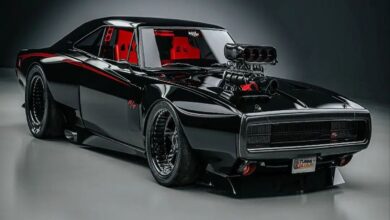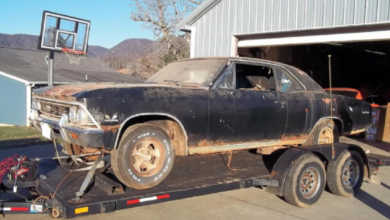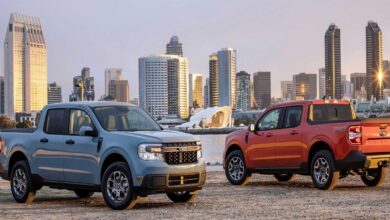Muscle Cars Were Slow . . . Part II.
A 1976 Trans-Am – doesn’t rate much when compared with even the base/V-6 powered versions of today’s muscle cars. Though it came with an engine packing more cubic inches (liters, in today-speak) than any of the new stuff (excepting the Viper, but that’s not fair because it’s got a V-10 and my Pontiac’s only got a V-8) the power output and performance – delivered in stock trim – was feeble. Or rather, is feeble – relative to the performance of today’s stuff: Zero to 60 in about 7.2 seconds, a low 15 second quarter mile – top speed (mechanically limited, due to the axle ratio and non-overdrive transmission) about 118 MPH.
But, Pontiac gave me a lot to work with. And – when the car was new – for about the cost of a current-day base V-6 powered sporty coupe. This opens some doors that are shut when you buy a new muscle car. If you can afford to buy a new muscle car.
My car’s sticker price, back in ’76, was about $5,800. Adjusted for inflation, this is equivalent to about $24,000 in today’s dollars (see here), which is almost to the dollar what Chevy asks for a brand-new (base trim/V-6 powered) Camaro: $23,555.
A V-8 powered Camaro SS stickers for $33,335 – about ten grand more, in real dollars, than my ’76 TA cost when new.
Stock vs. stock – and apples vs. oranges – the new Camaro V-6 is stronger/quicker – and much faster – than my old Pontiac was when it was new.
The V-8 Camaro SS even more so. It is literally no contest.
The 455 in my Trans-Am only managed 200 hp – out of 7.4 liters! . . . in stock trim. The new Camaro’s 3.6 liter V-6 (half the size of my TA’s V-8) makes 323 hp and the car can get to 60 in the sixxes. The Camaro SS’s 6.2 liter V-8 makes 426 hp and gets the car to 60 in 4.8 seconds.
Even more so when you factor in that the new car is wife-drivable (none of the really quick classic stuff was) has air conditioning, and you probably won’t need to touch much (other than oil/filter changes) for the next decade.
But, here’s the difference – Now vs. Then:
My Trans-Am, when it was new, was much more accessible. In the same way that a new V-6 Camaro is accessible. But when my TA was new, you got a V-8 Trans-Am, not a base trim V-6 Camaro. And that V-8 had tremendous performance potential locked up inside all those cubic inches, easily – and inexpensively (compared with today) accessed.
A new V-6 Camaro is – effectively – hyper-tuned. The as-delivered engine is optimized, or not far from it. The 455 that came in my TA was de-tuned. Deliberately crippled, in order to slide by the government’s emissions rigmarole, which was making it hard for GM to sell a V-8 at all, however gimped.
“Fixing” this – de-gimping the big V-8 – was the first thing most of us did, once we got our hands on something like the Trans-Am. We usually started by hacksawing off the factory exhaust system – which in those days garroted the output of the engine by 20 percent or more, due to the restrictive plumbing. Simply replacing the factory system (cast iron manifolds, narrow diameter – and often crimped – pipes, primitive catalytic converter) with headers and a good set of duals – sans the catalytic converters – freed up serious hp. And gained serious performance. For very little money. Even today, a set of headers for an old muscle car’s engine, a pair of free-flow mufflers and – if you must – a couple of modern high-flow catalytic converters (stand-alone units, they don’t need 02 sensors, because the car has no computer) will cost you about $1,000 or so.
And installation is DIY-doable, with hand tools.
This mod – along with some tuning work (adjusting the carburetor, ignition timing) which is free (or nearly free; replacement jets for the carburetor might cost you $20 or so) will make the TA perform better than a new V-6 Camaro. The horsepower number might not be as high – yet – but the big V-8 already produced a great deal more torque than the small V-6 in the new car. And the old car is much lighter than the new car. With 240-260 or so hp (and 450-plus ft.-lbs. of torque vs. the new Camaro V-6’s puny 278 ft.-lbs.) the otherwise stock 455 Trans-Am will be quicker than the new V-6 Camaro.
But wait, there’s more.
Spend another $300 or so – today’s dollars, much less back in the day – for a high-performance camshaft, also easily installed with hand tools – and without having to remove the engine, as you would in the new Camaro.
Now you’re in the 300-plus hp ballpark.
Maybe go ahead and pull the engine – very easy to do – and build the bottom end to complement the new camshaft. High-compression pistons, for instance. You could give the 455 – any classic muscle car V-8 – a mechanical makeover for a couple thousand dollars in parts and machine shop work.
And now, you’d be able to go toe-to-toe with a new Camaro SS.
For not much more than you’d have spent to buy a new Camaro V-6.
The new stuff comes ready to rock out of the box – provided you’ve got the wherewithal to afford the box. The old stuff was maybe a little tepid as it came, especially the mid-late ’70s stuff like my car, which bore the full brunt of Washington’s frontal assault against classic muscle cars. But one could buy them without breaking the bank – and have money left over to massage the potential Pontiac, et al, managed to smuggle past the gate.










